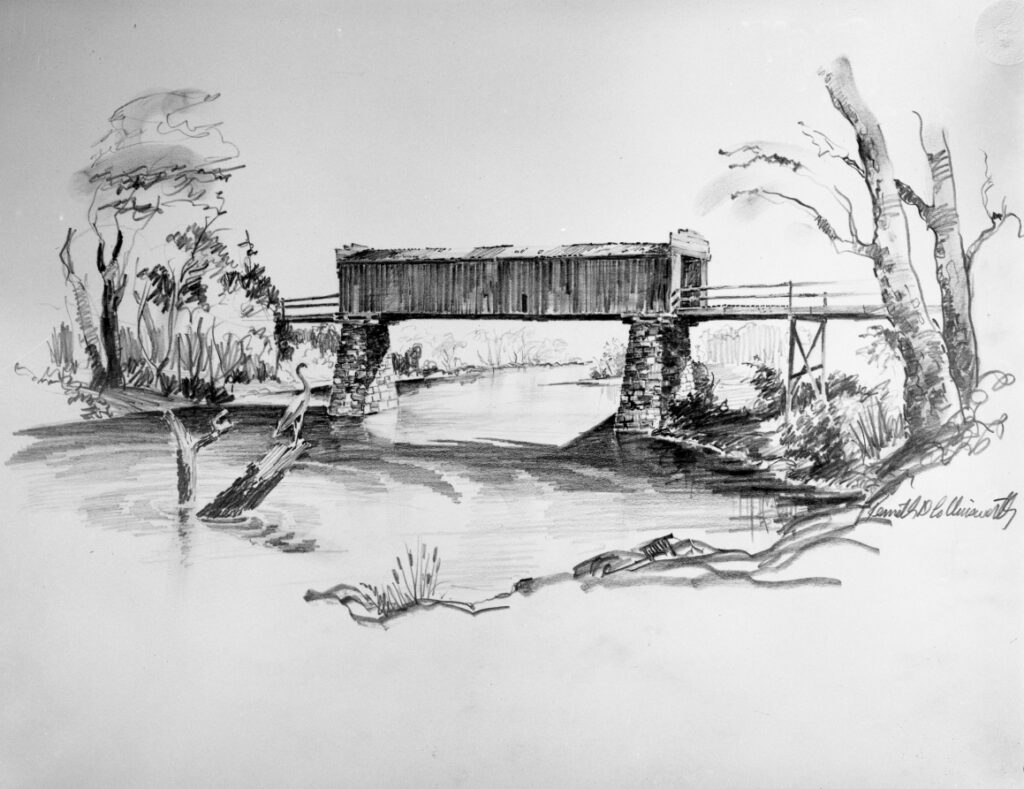Covered Bridges in Texas
Author: Melinda Luna PE
June 2024
Covered bridges were built in the United States between 1825 and 1875. The concept behind this bridge type was to construct a truss bridge and cover its main elements to protect them from the weather, thereby extending the bridge’s design life. This covering also provided pedestrians with shelter during storms and, in northern climates, kept snow off the bridge. Pennsylvania has the highest number of existing covered bridges. During the period of covered bridge construction, Texas was undergoing significant changes, including the fight for independence, becoming an independent country, achieving statehood, and experiencing the Civil War, which left little time for bridge building.

Charters were granted to individuals who could support the construction of roads and bridges, providing settlers with means to travel. One such charter was granted to John Mooney of Gonzales, Texas. The charter was highly specific about the tolls Mooney could charge, how the bridge had to be maintained, and other details. John Mooney, a farmer who built Gonzales College in 1852 (a building that still stands today at 820 St. Louis Street, Gonzales, Texas), began the bridge construction by building two stone piers in the San Marcos River. These piers would support the covered bridge span and connect to two approach spans.

Not much is known about the bridge itself. Measuring the river at the bridge’s location, the span had to be 100 feet. Given Mooney’s experience with stone construction, it is likely he sourced the stone for the piers from the same place as the college. There was also a supply of oak, which could have been used for the bridge’s construction. It is said that Mooney floated the truss in the San Marcos River and then built the covered bridge around it. The toll for crossing with a four-horse wagon was $0.50 ($18.44 in 2024 dollars) and one cent ($0.37 in 2024 dollars) for each head of sheep, pig, etc. The bridge, completed in 1856, was eventually sold by Mooney’s heirs to the county for $500 ($16,600 in 2024 dollars).
The town of Gonzales had a population of 300 in 1850, which grew to 1,700 by 1860. The covered bridge provided a reliable means of crossing the San Marcos River during inclement weather and likely withstood significant floods in 1869, 1870, and 1899. Another bridge was built alongside the original, which eventually fell into disrepair. A photograph from 1902 showing the two bridges is available at the Texas State Library.
Little is known about how John Mooney acquired his skills in building structures, roads, and bridges. Born in Georgia, he moved to Alabama and eventually to Texas, where he served in the military. His construction training may have come from his military service. The book “Building the Lone Star” contains a photograph of the bridge and mentions another covered bridge built in Texas, although its location is not specified. The San Marcos River covered bridge was located at approximately 29.505037355895436 -97.47798755224683.
The covered bridge type was a significant advancement in civil engineering, offering longer spans and extended design life.
Today, covered bridges are tourist attractions. Although some new covered bridges have been built in Texas, none from the original covered bridge era have survived. Recognizing the need for preservation guidance, the Federal Highway Administration (FHWA) published a Covered Bridge Manual in April 2005.



